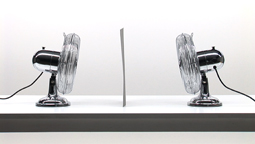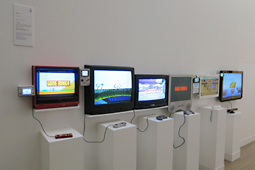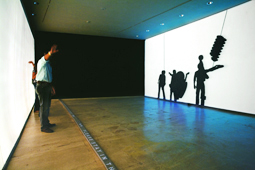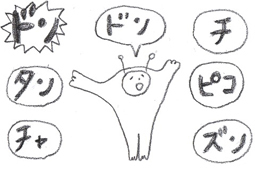 |
Toshio Iwai,
"Marshmallow Scope" (2002)
Photo: Keizo Kioku |
Open Space 2012 is the sixth annual long-term exhibition held at the NTT Intercommunication Center (ICC) located in the Tokyo Opera City Tower in Hatsudai, Tokyo. The show aims to provide a wide range of audiences with the opportunity to view new media-art created by prominent Japanese and international artists. Viewers can see how these creators integrate cutting-edge technologies into their artistic pursuits. As a venue, Open Space features diverse functions throughout two floors of exhibition spaces, a mini-theater, and a video archive lounge called The Hive.
Several works by emerging Japanese artists fill the lower level, including "Game Border" by Jun Fujiki (2011). This installation presents the 30-year evolution of video-game technology from the early Nintendo, Sega, and PlayStation consoles, through Wii and Xbox 360. Game design is an area where the synergies between art and technology have become impossible to overlook. Fujiki, who studied product, graphic and 3D interface design, is now a researcher at the Japan Science & Technology Agency. The game consoles and their respective monitors are displayed side by side so that the viewer may experience the progress of gaming technology sequentially. Visitors can start by playing the first game; when it is finished, the game character will appear to cross the "border" from one game into the next, which will then start.
Several of the Open Space installations on display are semi-permanent or making a repeat appearance, such as "Marshmallow Scope" by Toshio Iwai (2002). This life-sized, confectionery-like sculpture is equipped with its own video camera, enabling anyone who interacts with it to see the gallery from its perspective. In keeping with the theme of viewer participation, the piece looks soft and lovable, like a brand mascot, making the technology within more easily accessible.
 |
|
 |
| John Wood and Paul Harrison, "One More Kilometre" (2009) |
|
John Wood and Paul Harrison, "Fan/Paper/Fan" (2007) |
Long-time UK-based collaborators John Wood and Paul Harrison have six different videos looping on flat-screen monitors displayed throughout the exhibit spaces. With titles like "Fan/Paper/Fan," "One More Kilometre," and "Bored Astronauts on the Moon," their works span multiple genres, among them sculpture, performance art, and impromptu construction. Their films are often humorous and unpredictable, attempting to capture occurrences of physical phenomena such as gravity and tension. In a 2008 interview Wood says of their approach, "We are always trying not to repeat ourselves [and to see] how stripped down we can make something that is still watchable, or how densely we can push the ideas into one piece of work." ("John Wood and Paul Harrison," Tate Shots Interview, March 1, 2008; www.tate.or.uk)
Along with videos to watch, there is also an interactive video projection by Shilpa Gupta called "Untitled (Shadow 2)," the success of which is contingent on viewers' willingness to becoming participants. Visitors see their own shadows projected upon a screen; then the shadow of a wave emerges, and in silhouette the visitors seem to be walking upon waves. Shadows of various things that are not actually in the room begin to appear and these objects become animated in response to the visitors' interaction. One can reach up and open a window that suddenly materializes, revealing a world beyond; a bird appears which we can set free. Some of Gupta's previous work has a distinctly political message, but "Untitled (Shadow 2)" simply suggests that the viewer can become the artist, the author of his or her own experience.
 |
|
 |
| Jun Fujiki, "Game Border" (2011-12) |
|
Shilpa Gupta, "Untitled (Shadow 2)" (2006) |
"Room of Rhythmushi-san" by Tsubasa Naruse is another installation full of user-generated possibilities. A recent graduate of Tama Art University and Kunitachi College of Music, Naruse majored in sound and media art. His career is off to a promising start with the development of a series of animated music and dj-mixing applications for smart phones and tablets. In this space, visitors can explore the appfs functionality intuitively or with gentle prodding by the gallery staff on hand to assist. The playful interface, illustrated with Narusefs kawaii hand-sketches, is addictive in its simplicity.
Open Space 2012 offers visitors the chance to experience pure silence, an implausible feat in Tokyo. In the Anechoic Room, all sound generated outside or within the chamber is totally absorbed, simulating a quietness of near-infinite dimension. When American experimental composer John Cage visited a similar room at Harvard University in 1951, the experience is said to have inspired his best known piece, "4'33." Including the Anechoic Room in the exhibition reminds us of the origins of art that defies simple categorizing and puts the work of these current-day practitioners into a larger context. All of the pieces on display are engaging and thought-provoking without being overly "provocative," helping to make this exhibition accessible to the general public, including families. Some shows are well worth visiting at an unpopular hour to avoid the crowds. It is more fun to experience Open Space 2012 at a peak time, however, to see other visitors shed their inhibitions and share in the delight of discovering these works together.
 |
|
 |
Anechoic Room
Photo: Keizo Kioku |
|
Tsubasa Naruse, "Room of Rhythmushi-san" (2010)
All images courtesy of ICC Tokyo Opera City |
|